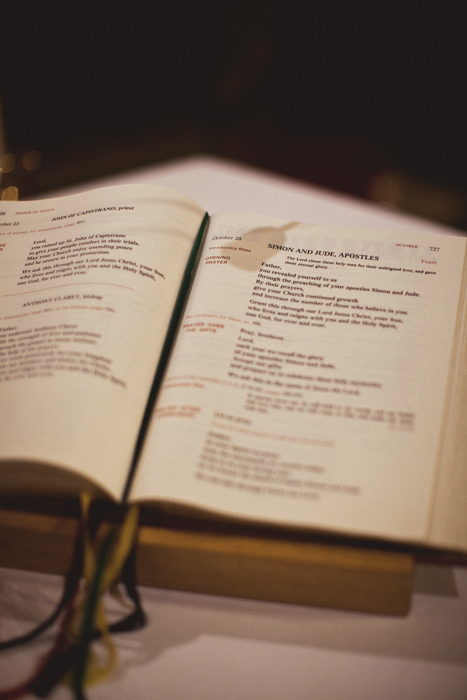Why the Lectionary?

A growing number of congregations are reaching for a resource called a lectionary for the selection of Bible texts to be used in the worship and preaching of each Lord’s Day. This may seem to be an innovation to many Nazarenes who have not been familiar with this resource and who may not understand why it is increasing in usage.
What is a Lectionary?
Lectionaries are simply lists of Bible texts that are usually selected by a committee of scholars and pastors. The most common lectionary in use among Nazarene congregations today may be the work of The Consultation on Common Texts (1983, revised in 1992) with representatives from a wide spectrum of denominations, including Wesleyan groups. Although the Revised Common Lectionary may be a common tool, there are a number of lectionaries in use across the Church of Jesus Christ, including daily lectionaries for devotional reading.
The idea of gathering an ordered list of texts is not new. It is rooted in Jewish religious practice. There is also early evidence in the life of the church that Christians began to do this as a way to ensure that the church was hearing the rich scope of biblical texts and not just a select few repeated over and over.
It is connected to the rhythms of the Christian year as we annually tell the story of our redemption “from creation to covenant to slavery to exodus to sacrificial worship to prophecy and judgment to silence to incarnation of God’s self in Jesus of Nazareth to the pouring out of the Holy Spirit to the complete redemption of all things!”1 The telling of this story begins each year with Advent and focuses especially on the birth, life, suffering, death, resurrection, and ascension of our Lord Jesus.
The lectionary gathers for each Sunday a reading from the Old Testament, New Testament, and a Gospel, as well as a Psalm.
These texts are thematically connected to each other and to the particular Sunday in the Christian year. There is a three-year cycle, so that over time the congregation hears from a balanced selection of Bible passages.
Some may argue that each pastor or each congregation should select Bible readings that fit the moment and location of their experience, being directed by the Spirit in prayer. It is certainly true that the work of preparation for worship and preaching must be done prayerfully and with sensitivity to the life of each particular congregation. However, it is remarkable how regularly the assigned texts for each Sunday align with the need of the congregation in a particular moment. The Holy Spirit is not bound to our experience of time and space.
Reasons Churches Use the Lectionary
There are several compelling motivations for using a lectionary:
- We share the hearing of the Bible with Christians around the world. This is one way to live into the prayer of our Lord, that we would live in unity as God’s people. Practically, it opens fellowship with Christians of other congregations who are hearing and responding to the same texts.
- These texts were gathered with theological intention as they narrate together the story of God and the Gospel of Jesus Christ. As “members one of another” (Rom 12:5, NRSV), we live under a wisdom that is larger than our own experience. There is something important about coming under the authority and wisdom of the church in this way. As Gordon Lathrop notes, when Jesus was invited to read Scripture in the synagogue, even He was handed the scroll of Isaiah in the Luke 4 account.2 This can be liberating for the pastor who is able to move from the question of “what to preach” to “how to proclaim faithfully” the texts that are assigned.
- The lectionary selections help us with the temptation to default to texts with which we are most familiar, which is dangerous because we tend to stop truly hearing familiar texts. It presses us beyond “proof texts” to an expansive view of the whole story of God
- Because the lectionary typically assigns four texts for each Sunday (sometimes alternate readings are given), this provides a substantive resource for congregations to make sure that the reading and hearing of the Bible remains an essential component of gathered worship. This may seem obvious, but far too many congregations experience precious little reading of the Scriptures in corporate worship.
It seems that some of us worry that accessing the liturgical resources of the church somehow puts us in danger of dead ritual or form for its own sake. This is a category mistake. Liturgies (which are about the shared work of the people of God in worship) are neither dead nor alive; people are either dead or alive! If our worship has become dull or “dead,” it is time to revive our prayerful engagement with the Word of God under the power of the Spirit.
The lectionary is a tool that can guide us into renewed engagement with the Bible.
An Invitation
This is not an argument for use of the Lectionary for its own sake. It is an invitation to explore how this rich resource could bring needed renewal to many of our congregations who are impoverished when it comes to hearing the “whole counsel of God” in worship.
At the least, rather than becoming dismissive of this practice because it is unfamiliar, perhaps we could be open to the idea that the Holy Spirit is working through a tool like the lectionary to guide the Church of Jesus Christ into passionate, Spirit-filled, and thoughtful engagement with the Word of God in our worship.
Jeren Rowell is president of Nazarene Theological Seminary in Kansas City, Missouri, USA.
1. Jeren Rowell, These Forty Days: A Lenten Devotional (Kansas City, MO: Beacon Hill Press, 2013), 6.
2. Gordon Lathrop, The Pastor, A Spirituality (Minneapolis, MN: Fortress Press, 2006), 41.
Holiness Today, November/December 2018
Please note: This article was originally published in 2018. All facts, figures, and titles were accurate to the best of our knowledge at that time but may have since changed.




